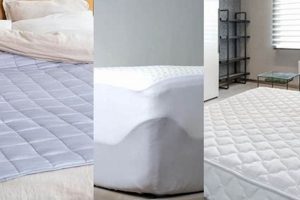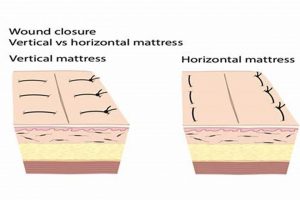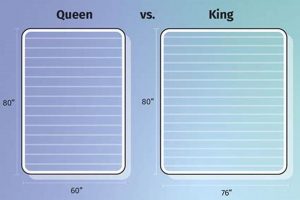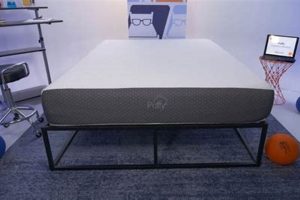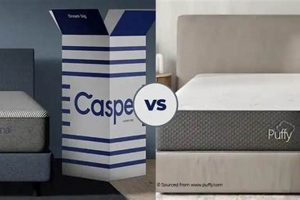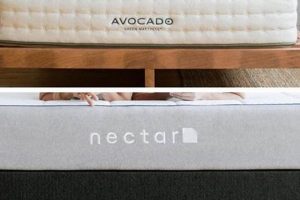The comparison of a thin, protective layer for a mattress with a thicker, comfort-enhancing addition is a common consideration for consumers. The former primarily serves to shield the mattress from spills, stains, and wear, acting as a barrier between the sleeper and the mattress surface. A typical example is a quilted cover secured with elastic straps at the corners. The latter, conversely, is designed to alter the feel of the sleeping surface, potentially adding softness, firmness, or pressure relief. A memory foam addition, several inches thick, exemplifies this type of product.
Understanding the distinct purposes of each item allows individuals to optimize their sleep environment based on specific needs and preferences. This knowledge can lead to increased mattress longevity and improved sleep quality. Historically, protecting mattresses from damage has been a primary concern, leading to the initial development of basic coverings. Over time, evolving material technologies and a greater emphasis on sleep ergonomics have driven the development of more sophisticated options aimed at enhanced comfort.
The following discussion will delve into the specific attributes of each option, exploring materials, thicknesses, benefits, and drawbacks. A careful examination of these factors will assist in making an informed decision based on individual circumstances and desired outcomes. This includes considerations for budget, sleep style, and the existing condition of the underlying mattress.
Guidance on Mattress Enhancements
This section offers practical advice for choosing between protective layers and comfort layers for a mattress. Careful consideration of these points can lead to a more satisfying sleep experience and extend the life of the mattress.
Tip 1: Assess Existing Mattress Condition: Evaluate the current state of the mattress. If the mattress is new or in good condition, a protective layer is generally sufficient. For older mattresses exhibiting signs of wear, a comfort layer may be more appropriate.
Tip 2: Define Primary Need: Determine whether the main goal is protection or comfort adjustment. If preventing spills and stains is the priority, a protective layer is the optimal choice. If the objective is to alter the firmness or feel of the mattress, a comfort layer is indicated.
Tip 3: Consider Material Properties: Different materials offer varying degrees of protection and comfort. Protective layers often utilize waterproof or stain-resistant fabrics. Comfort layers can incorporate memory foam, latex, or down alternatives, each with unique properties affecting temperature regulation and support.
Tip 4: Evaluate Thickness and Profile: A thin profile is characteristic of protective layers, designed to be unobtrusive. Comfort layers are typically thicker, ranging from two to four inches, impacting overall bed height and feel.
Tip 5: Budget Considerations: Protective layers are generally less expensive than comfort layers. Establish a budget before exploring options to ensure financial alignment with needs and expectations.
Tip 6: Maintenance Requirements: Understand the cleaning and care instructions for each option. Protective layers are often machine washable, while comfort layers may require spot cleaning or professional cleaning.
Tip 7: Address Specific Sleep Concerns: If specific issues such as pressure points or overheating are present, select comfort layer materials designed to mitigate these concerns. Memory foam can alleviate pressure, while latex and certain down alternatives promote airflow.
Prioritizing the above tips will help guide the decision-making process, leading to a better understanding of protective versus comfort additions and ultimately, a more restful sleep.
The following section will delve into the long-term implications of choosing one option over the other, focusing on mattress longevity and continued comfort.
1. Protection Level
The degree of safeguarding afforded to a mattress is a primary differentiator between a thin protective layer and a thicker comfort layer. Protective layers, often waterproof or water-resistant, are specifically designed to shield the mattress from liquids, stains, and allergens. This prevents premature wear and tear caused by spills, bodily fluids, and dust mite accumulation. For example, a basic cotton or polyester layer with a polyurethane backing acts as a barrier against spills, preventing them from penetrating the mattress core. This simple action can significantly extend the lifespan of the mattress, especially in households with children, pets, or individuals prone to nighttime accidents.
Conversely, comfort layers offer minimal direct protection. While a thick memory foam or latex addition might absorb some surface spills, it is not inherently designed to be waterproof or stain-resistant. The primary focus is on altering the feel of the sleep surface, enhancing comfort, and providing pressure relief. Thus, opting solely for a comfort layer leaves the underlying mattress vulnerable to damage. In situations where both comfort enhancement and protection are desired, a combination of a waterproof protective layer beneath a comfort layer is often the most effective strategy.
In conclusion, the extent of safeguarding provided is a critical factor when choosing between a protective layer and a comfort layer. While a comfort layer may indirectly contribute to mattress longevity by reducing movement and friction, it cannot replace the dedicated protection offered by a waterproof or water-resistant pad. Understanding this distinction allows consumers to make informed decisions, balancing comfort needs with the practical requirement of preserving the investment in their mattress.
2. Thickness Variation
Thickness serves as a primary distinguishing characteristic between a thin protective layer and a thicker comfort layer. The former, designed for mattress preservation, typically measures less than one inch in thickness. This minimal profile ensures that it does not significantly alter the existing feel of the mattress. A quilted cotton or polyester cover exemplifies this category. Its purpose is to create a barrier against spills and stains without dramatically impacting the sleep surface’s firmness or support. The thinness facilitates ease of laundering and handling, as well as compatibility with fitted sheets.
Conversely, comfort layers are characterized by their substantial thickness, ranging from two to four inches or more. This added depth directly correlates with the degree of comfort modification they provide. A memory foam or latex addition, for instance, utilizes its thickness to contour to the body, alleviate pressure points, and potentially alter the overall firmness of the mattress. Thicker additions offer a more pronounced change in the sleeping experience but may also require deeper fitted sheets and could impact the overall bed height. The increased material volume necessitates more careful consideration of material properties, such as density and breathability, to ensure optimal comfort and temperature regulation.
In summation, the disparity in thickness between protective and comfort layers reflects their fundamentally different purposes. While thin protective layers prioritize mattress preservation with minimal alteration of the sleep surface, thicker comfort layers aim to enhance comfort and adjust the feel of the mattress. Understanding this thickness variation is critical for consumers seeking to balance mattress protection with desired improvements in sleep quality and support. The choice hinges on individual needs, preferences, and the current condition of the underlying mattress.
3. Comfort Enhancement
Comfort enhancement represents a primary motivation for individuals considering additions to their mattresses. Within the context of protective layers and comfort layers, the degree to which each option contributes to improved sleep quality and physical well-being differs significantly. Protective layers, while essential for preserving the integrity of the mattress, offer minimal direct comfort enhancement. Their function is primarily preventative, guarding against spills, stains, and allergens. The slight cushioning they provide is incidental to their protective role. Conversely, comfort layers are specifically engineered to alter the feel of the sleep surface, thereby directly influencing comfort levels. For example, a memory foam comfort layer conforms to the body’s contours, reducing pressure points and promoting spinal alignment. This results in a more comfortable and restful sleep experience. Similarly, a latex addition offers resilient support and pressure relief, appealing to individuals seeking a firmer yet comfortable sleep surface.
The selection between a protective layer and a comfort layer hinges on the individual’s priorities and the existing characteristics of the mattress. If the mattress provides adequate comfort and support, a protective layer may suffice. However, if the mattress is too firm, too soft, or exhibits signs of wear that compromise comfort, a comfort layer becomes a viable solution. Furthermore, individuals with specific physical needs, such as chronic pain or pressure sensitivity, may benefit significantly from the targeted comfort enhancement offered by specialized materials. The effectiveness of comfort enhancement also depends on the quality and density of the materials used. Higher-density memory foam, for example, provides greater support and durability compared to lower-density alternatives. Therefore, careful consideration of material properties is essential when selecting a comfort layer.
In conclusion, comfort enhancement constitutes a key element in the evaluation of protective layers versus comfort layers. While protective layers indirectly contribute to long-term comfort by preserving the mattress’s condition, comfort layers directly address the immediate need for improved sleep quality and physical well-being. The choice ultimately depends on the individual’s specific needs, preferences, and the condition of the underlying mattress. A balanced approach, potentially combining a protective layer with a comfort layer, can optimize both mattress longevity and sleep satisfaction.
4. Material Composition
The selection of materials fundamentally defines the characteristics and performance of both protective layers and comfort layers. The material composition dictates properties such as breathability, durability, support, and hypoallergenic qualities. A protective layer composed of tightly woven cotton or polyester, often treated with a water-resistant coating, effectively shields the mattress from liquids and stains. The tight weave prevents penetration, while the coating enhances liquid repellency. Conversely, a comfort layer might utilize memory foam, latex, or down alternatives. Memory foam’s viscoelastic properties allow it to conform to the body, relieving pressure points. Latex offers a more resilient and supportive feel, while down alternatives provide a soft and plush surface. Each material introduces unique benefits and drawbacks, influencing the overall comfort and longevity of the product. For example, a comfort layer incorporating gel-infused memory foam may enhance temperature regulation, mitigating heat retention commonly associated with traditional memory foam.
The specific materials employed directly influence the practical application and suitability of each product. A protective layer intended for individuals with allergies might utilize hypoallergenic materials, such as tightly woven microfiber, to minimize dust mite accumulation. A comfort layer designed for side sleepers could incorporate a softer material, like plush memory foam, to alleviate pressure on the shoulders and hips. The choice of material also affects maintenance requirements. Cotton protective layers are generally machine washable, while memory foam comfort layers may require spot cleaning or professional cleaning. The long-term performance and durability are also contingent on the material’s quality and construction. A high-density memory foam comfort layer will typically maintain its shape and support longer than a low-density alternative. Therefore, a thorough understanding of material properties is essential for making an informed decision.
In summary, the material composition is a critical determinant of the effectiveness and suitability of protective layers and comfort layers. The selected materials directly impact properties such as protection, comfort, durability, and maintenance. Consumers should carefully consider their individual needs and preferences when evaluating different materials, balancing the benefits and drawbacks of each option. While a basic protective layer might prioritize affordability and ease of care, a high-quality comfort layer could offer superior comfort and support. Ultimately, the ideal choice depends on the individual’s specific requirements and the desired outcome.
5. Cost Differential
The price variation between a mattress pad and a mattress topper represents a significant factor in consumer decision-making. Understanding the cost implications associated with each option is crucial for aligning budgetary constraints with desired sleep enhancements.
- Material Costs
Material selection heavily influences the final cost. Basic mattress pads, often constructed from cotton or polyester blends, generally exhibit lower material costs compared to mattress toppers. Toppers frequently incorporate premium materials such as memory foam, latex, or specialized fiber fills, contributing to a higher price point. For instance, a simple quilted pad may cost significantly less than a memory foam topper of comparable size.
- Manufacturing Complexity
The complexity of the manufacturing process impacts production costs. Mattress pads, typically involving simpler construction techniques, require less labor and specialized equipment, resulting in lower manufacturing expenses. Mattress toppers, often featuring intricate designs and multiple layers, necessitate more complex manufacturing processes, translating to higher production costs. Examples include multi-zone toppers designed for targeted support or those with advanced cooling technologies.
- Longevity and Replacement Frequency
The expected lifespan and replacement frequency affect the overall cost-effectiveness of each option. Durable mattress pads, with proper care, can provide years of protection, minimizing the need for frequent replacements. Mattress toppers, while potentially offering superior comfort, may require more frequent replacement due to material degradation or compression. This shorter lifespan increases the long-term cost. Consider a scenario where a budget pad lasts for five years, whereas a more expensive topper needs replacement after three years.
- Feature Set and Additional Benefits
Additional features and benefits contribute to the cost differential. Basic mattress pads offer minimal additional features, focusing primarily on protection. Conversely, mattress toppers may incorporate advanced features such as enhanced breathability, temperature regulation, or targeted support zones. These added benefits increase the product’s value proposition and, consequently, its price. As an illustration, a basic pad will not offer the cooling effects provided by a gel-infused memory foam topper.
The cost differential between a mattress pad and a mattress topper reflects variations in material costs, manufacturing complexity, longevity, and included features. While mattress pads offer an economical solution for basic mattress protection, mattress toppers provide enhanced comfort and specialized benefits at a higher price point. The optimal choice depends on individual budgetary considerations and desired sleep enhancements. A cost-benefit analysis should weigh the initial investment against the long-term value and potential benefits of each option.
Frequently Asked Questions
This section addresses common inquiries regarding the distinctions and applications of mattress pads and mattress toppers, providing clarity on their respective functions and benefits.
Question 1: What is the primary function of a mattress pad?
The primary function of a mattress pad is to protect the mattress from spills, stains, allergens, and general wear and tear. It acts as a barrier between the sleeper and the mattress surface, extending the mattress’s lifespan.
Question 2: How does a mattress topper differ from a mattress pad?
A mattress topper is designed to alter the feel and comfort of the mattress. It adds an extra layer of cushioning or support, potentially changing the firmness, pressure relief, or temperature regulation of the sleep surface.
Question 3: Is a mattress pad or a mattress topper more suitable for addressing back pain?
A mattress topper is generally more effective for addressing back pain. Its thicker profile and specialized materials, such as memory foam or latex, can provide targeted support and pressure relief, promoting spinal alignment.
Question 4: Can a mattress pad improve the comfort of an old mattress?
A mattress pad can provide a slight improvement in comfort, but its impact is limited compared to a mattress topper. If the primary goal is to significantly enhance comfort, a mattress topper is the more appropriate choice.
Question 5: How does the cost of a mattress pad compare to that of a mattress topper?
Mattress pads are typically less expensive than mattress toppers. The lower cost reflects the simpler construction and less expensive materials used in their production.
Question 6: What are the typical materials used in mattress toppers?
Common materials found in mattress toppers include memory foam, latex, down alternatives, and various fiber blends. Each material offers unique properties in terms of support, pressure relief, and temperature regulation.
In summary, mattress pads primarily serve a protective function, while mattress toppers are designed to enhance comfort. The choice between the two depends on individual needs, budgetary constraints, and the desired level of sleep surface modification.
The subsequent section will provide guidance on selecting the most appropriate option based on specific circumstances and preferences.
Conclusion
The preceding exploration of mattress pad vs topper reveals distinct functionalities and benefits. The former serves primarily as a protective barrier, extending the lifespan of the mattress by mitigating the impact of spills, stains, and allergens. The latter, conversely, focuses on enhancing comfort, potentially altering the firmness, pressure relief, and temperature regulation of the sleep surface. The selection hinges on a careful evaluation of individual needs and priorities, considering factors such as mattress condition, desired comfort level, and budgetary constraints.
A judicious approach to choosing between a mattress pad vs topper will yield improved sleep quality and long-term satisfaction. Prioritizing individual requirements and a thorough understanding of available options ensures an informed decision. Continuing advancements in material science and sleep technology promise future innovations that will further refine the distinctions and enhance the benefits of both mattress pads and toppers, ultimately contributing to a more restful and rejuvenating sleep experience.


